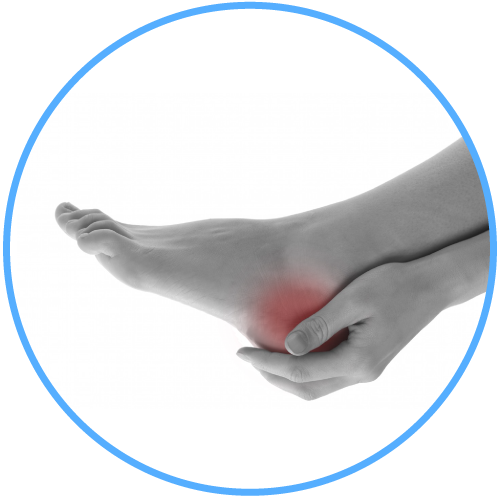
Plantar Fasciitis
The plantar fascia is a thick band of tissue that runs along the sole of the foot. Examination reveals well localised and tender pain over the planter fascia and that is aggravated by repetitive loading on the foot and fascia in activities such as walking, running and jumping.
Plantar fasciitis occurs with a gradual onset of pain by the medial heel. Initially the symptoms appear worst in the morning or after bearing no weight for prolonged periods of time and on bare foot walking. Many people experience exacerbated symptoms post extended durations of exercise.
Physiotherapy treatment for plantar fasciitis includes
- Therapeutic soft tissue techniques
- Therapeutic exercises (strengthening, stretching, balance and proprioception)
- Custom footwear
- Joint mobilisation
- Gait re-education
Achilles Tendinopathy
Overuse, misalignment, improper footwear can all result in Achilles Tendon injuries. An increase in physical activity, altered foot biomechanics i.e. fallen arches or overpronation. Achilles tendinopathy is a common injury among middle and long distance runners characterised by soreness and stiffness that comes on gradually and continues to worsen until treated. Men over the age of thirty are more prone to this type of injury. It often starts with stiffness and pain when first getting out of bed in the morning. Additionally, Achilles tendon rupture is a partial or complete tear of the Achilles tendon. It comes on suddenly, sometimes with a popping sound, and is debilitating. Partial and full Achilles tendon ruptures are most likely to occur in sports requiring sudden eccentric stretching such as sprinting and racquet sports.
Physiotherapy Treatment for Achilles Tendinopathy
- Stretching of the calve muscle
- Graded exercise programme including exercises to improve strength and endurance of the calve and Achilles tendon
- Soft tissue release
- Education on icing and provocative activities
Ankle fracture
The ankle joint is made up of three bones: the shinbone (tibia), the lower leg bone (fibula), and the ankle bone (talus). One or more of these bones can break when excessive stress, twisting, or trauma is placed on the ankle joint. Because a severe ankle sprain can feel the same as a broken ankle, a physician should access every ankle injury. Immediate treatment typically includes a splint to immobilize the ankle. Physiotherapy rehabilitation is very important regardless of how an ankle fracture is treated. Typical physiotherapy treatment includes
- Therapeutic soft tissue techniques
- Therapeutic strapping and bracing
- Therapeutic exercises (strengthening, stretching, balance and proprioception)
- Range of motion exercises
- Gradual return to sport/activity rehabilitation
Ankle sprain
Ankle sprains usually occur in activities requiring rapid changes in direction, especially if these take place on uneven surfaces (grass fields). They are also seen when a player, having jumped, lands on another competitor’s feet. They are one of the most common injuries seen in basketball, rugby, hurling and most football codes.
Depending on the severity of the ligament injury, the athlete may continue to play or need to be taken off. Swelling and redness usually appears rapidly, although occasionally it may be delayed some hours.
Treatment
The goal of physiotherapy for ankle sprains is to reduce pain and swelling, restore full range of motion and improve muscle conditioning and proprioception in order for the patient to return to their pre-injured level of sport/activity.
Treatment modalities:
- Therapeutic soft tissue techniques
- Therapeutic strapping and bracing
- Therapeutic exercises (strengthening, stretching, balance and proprioception)
Calve strain
Calf strain is a common injury in sports that involve sudden bursts of speed, such as football, hurling, and rugby. Calf pain is a common compliant, along with swelling and bruising, however, if it not managed appropriately it can persist for months or recur.
The physiotherapy treatment of calf injuries depends on the severity of the injury.
- Therapeutic soft tissue techniques
- Therapeutic exercises (strengthening, stretching)
- Balance and proprioception exercises
Shin Splints & Medial tibial stress syndrome
The term “shin splints” is commonly used to describe the pain resulting from the injury of the muscles running along the medial border of the shin. It usually occurs when performing activities in which the feet repetitively hit the ground (running on hard surfaces and Irish dancing).
Treatment
- Therapeutic soft tissue techniques
- Therapeutic exercises (strengthening, stretching)
- Significant biomechanical abnormalities may need correction with orthotics
- Gait re-education
Servers Lesion
An inflammation of the growth plate in the heel of growing children, typically adolescents. The condition presents as pain in the heel and is caused by repetitive stress to the growth plate in the heel. Typical Physiotherapy treatment includes
- Graded exercise programme including stretching and strengthening of the calve and ankle
- Soft tissue techniques
- Reducing the provocative activity
Fallen arches
A fallen/dropped arch is a postural deformity in which the arches of the foot collapse, with the entire sole of the foot coming into complete or near-complete contact with the ground.
Stress Fracture
A fracture of a bone caused by repeated (rather than sudden) mechanical stress.
Heel Spur
A heel spur develops as an abnormal growth of the heel bone. Calcium deposits form when the plantar fascia pulls away from the heel area, causing a bony protrusion to develop



